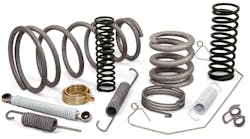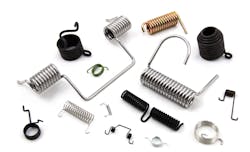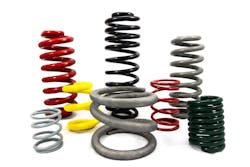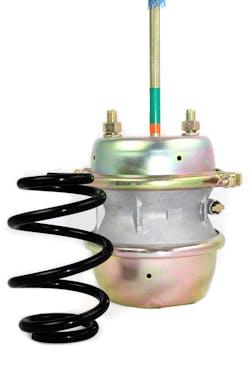Your Spring Choices Matter—and What They Mean for Manufacturers
Springs may not be at the top of a designer’s mind when working on an application, but they are essential in many applications. The sizes and types available vary greatly and their choice is influenced by application parameters and industry requirements. Manufactured from many different materials that must often meet international standards, they can be coiled, wire-formed, or stamped by presses to achieve the desired spring shape and properties.
Spring Types
This article will look at the choices of springs in the automotive, healthcare and medical, and agricultural industries. The types commonly used are:
- Belleville washers, also known as coned-disc springs, conical spring washers, disc springs, Belleville springs, or cupped spring washer These are conical shells that can be loaded along their axes either statically or dynamically.
- Compression springs are usually of a coil type and offer resistance to a force tending to compress a spring.
- Constant-force springs exert a constant force over their range of motion and do not obey Hooke's law. Generally they are constructed as a ribbon of spring steel that rolls up when relaxed.
- Extension springs, also known as a tension spring, are designed to store energy and exert a specified pull force when extended to a specific length.
- Power springs, also known as clock springs, store and release large amounts of rotational energy in the form of torque.
- Torsion springs work by torsion or twisting. When twisted, they exert torque in the opposite direction proportional to the amount they are
- Wave springs, also known as coiled wave springs, are made up of pre-hardened flat wire. They are composed via a process called on-edge coiling or edge-winding, which adds a wave to provide the spring
Torsion springs work by torsion or twisting. They are used in automotive and agricultural applications.
Automotive Springs
Springs are utilized throughout a vehicle’s interior and exterior, as well as within the engine:
- Compression springs are used in anti-lock brake systems and fuel injectors along with locks, pumps, and valves. The most common form is a straight cylindrical formed from round wire, but they are also used in other complex shapes. These include hourglass, conical, barrel, square, ovate, rectangular, and those with reduced ends that are produced from round or flat wire.
- Extension springs are used in what are termed foundation brake components, the brake-assembly components at the wheels of a vehicle.
- Power springs are used in retractor mechanisms such as those found in seatbelts.
- Torsion springs are used as couplings between concentric shafts, such as in a motor pump assembly, and are typically found in single- or double-coil forms.
- Coil springs are often found in heavier trucks, specifically on the front suspension between the upper and lower control arms. These springs are suitable to carry heavy loads and are therefore also used within the air brake assembly.
- Belleville washers are used in clutch and brake mechanisms, as well as in transmissions.
Healthcare and Medical Springs
Compression springs are usually of a coil type and offer resistance. They are used in the healthcare industry for prosthetic limbs.
Within the healthcare and medical industry, springs can be found in devices as diverse as x-ray machines, bed lift mechanisms, and drug infusers. There are a multitude of springs available to accommodate myriad applications. While some springs dampen force and perform a pushing action, others oppose extension by pulling themselves back together.
- Compression springs are used in prosthetic limbs to enhance performance or when a squeezing action is needed, such as in a surgical stapler.
- Extension springs are used in stretchers, surgical lights, and a number of small handheld devices.
- Constant force springs, either motor type (drum take-up) or extension type (strip end connection), are often found in surgical instruments and MRI machines.
- Wave springs are sometimes specified in place of conventional round wire compression springs. Generally, wave springs occupy 30 to 50% of the compressed height space of comparable round wire springs, offering more deflection with the same load specifications. They are used in drug delivery devices (especially EpiPens or insulin pens), as well as in support of prosthetics and orthotics.
Many of these healthcare and medical applications are hygienic and require production in cleanrooms. In addition, shoulder-to-shoulder engineering can be instrumental in helping device makers to go from initial design through to market. Spring suppliers should also be able to offer a range of finishes and surface coatings to enhance application performance.
Agricultural Springs
In agricultural applications, springs are found in many types of farming equipment, from seed meters and harvesters to irrigation systems, mowing equipment, and tractors. They need to be reliable in extreme temperatures, be able to work effectively in dirty environments, and handle pressure loads.
- Compression springs are needed to support a variety of the load requirements of an agricultural setting and are used widely in irrigation, such as in pop-up sprinkler heads.
- Spring clips and pins are used to support farmers in properly attaching tractor hitches.
- Specialized springs and wire forms are found in hydraulic systems, planters, and cutters.
- Tines are heavy wire forms on machines that work the field soil.
- Torsion springs, extension springs, and other types of springs are often used in combination within various gas-powered handheld lawn equipment.
Shown is an example of a spring used in a automotive brake. Belleville washers are used in clutch and brake mechanisms as well as in transmissions.
Springs play an important role in the automotive, healthcare and medical, and agricultural industries, impacting performance and helping provide optimal operating scenarios. However, it is vital that the correct type of spring is chosen from the large variety of types on the market. To ensure the best performance in every case, though, each individual application should be investigated. In most cases, a custom solution will be required.
David Payunk is a product manager for springs at Trelleborg Sealing Solutions.




